Development Update on the Next-Generation Porsche 718 EV
公開日:2024.12.05

コンテンツ
Development Status of the Porsche 718 EV
The news that Porsche is advancing the development of electric versions of the 718 Boxster and Cayman is incredibly exciting for many EV enthusiasts. I myself have a strong interest in the 718 EV, and honestly, I’m more intrigued by the 718 EV than the later stages of the 992 series.
However, there have been reports of Porsche revising its electrification plans, which has caused some concern about the future of the 718 project. Amidst this, Michael Steiner, Porsche’s Head of Research and Development, has shared some fascinating insights about the development status of the 718 EV, which I’d like to introduce.
According to Steiner, the electric 718 Boxster and Cayman are being developed on a unique platform that leverages racing technology to deliver pure sports car performance.
Design Focused on Handling
One of the reasons the current 718 series is highly praised is its excellent handling performance.
This characteristic mainly comes from two factors: lightweight design and the weight distribution enabled by the mid-engine layout.
For the 718 EV, Porsche has maximized the efficiency of the regenerative braking system to achieve a smaller, lighter battery pack. What’s even more interesting is the battery placement. Instead of the typical flat layout under the floor found in most electric vehicles, Porsche is adopting a unique “core” layout.
In this layout, the battery is positioned behind the seats, achieving a center of gravity similar to that of the traditional 718 with an internal combustion engine. Steiner explains:
“By bringing the center of gravity as close to the driver as possible, the overall flexibility and agility of the car improve. The result is a well-balanced, easy-to-handle vehicle.”
Additionally, this layout allows the driver to sit lower, enhancing the sporty driving feel.
Brake Performance Learned from Formula E
To succeed with the electric vehicle’s core platform, it was necessary to maximize efficiency and reduce battery size.
Steiner says special attention was paid to blending regenerative braking with conventional brakes to balance efficiency and braking performance.

As a result, the one-pedal driving system will not be adopted. Steiner explains:
“If you ask racing drivers, none would choose a one-pedal system. It’s crucial to control regenerative and conventional braking seamlessly with the same pedal. Without proper pedal feel during cornering, you can’t trust the car’s stability.”
Steiner notes that perfecting the brake feel during cornering is something they learned from Formula E.
Brake System Optimized for Sports Driving
According to Steiner, the one-pedal braking system tends to activate regenerative braking earlier than ideal for performance driving. By consolidating all brake control into the actual brake pedal, drivers can perform the necessary modulation and also sense road surface and steering feedback.
“You can control the car with both the brake and the accelerator,” Steiner says.
In this way, Porsche is actively applying racing technology in the development of the 718 EV, focusing on preserving the characteristics of a traditional sports car even as an electric vehicle.
It seems Porsche’s sports car spirit will remain intact in the era of electrification. I’m already looking forward to the announcement of the 718 EV.
このブログが気に入ったらフォローしてね!


Comment ( 0 )
Trackbacks are closed.
No comments yet.